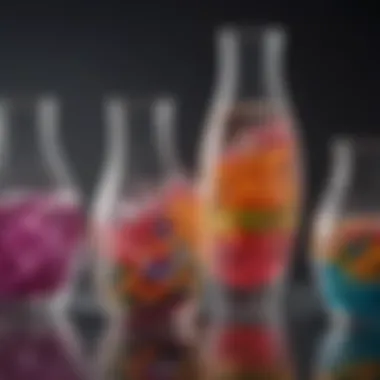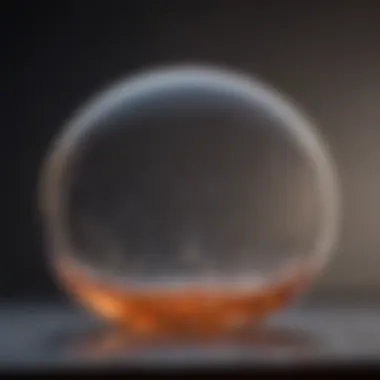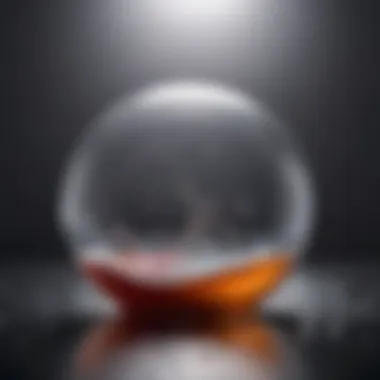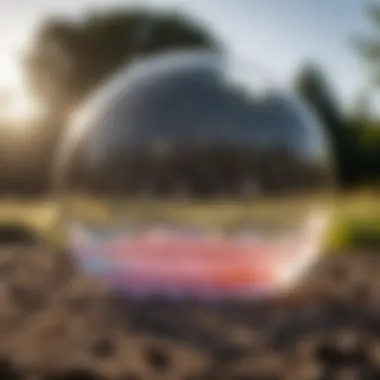The Best Mix for Bubbles: Optimal Blends Explored


Intro
Bubbles captivate everyone, young and old alike. The joy of watching glistening spheres float and burst ignites imagination. However, not all bubble solutions are made equally. This article focuses on optimal blends that elevate the bubble-making experience. We will explore preparations, essential ingredients, and the science behind bubble formation.
It is essential to understand how different ingredients blend together to create more durable and larger bubbles. Factors such as surface tension greatly influence bubble performance. Whether for fun, education, or a specific purpose, you can create the perfect mixture tailored to your needs. Throughout this exploration, we will dissect notable recipes, useful techniques, and common pitfalls to avoid.
Join us as we unlock the art and enjoyment of achieving superior bubbles, irrespective of your experience level.
Recipe Highlight
Featured Bubble Solution: Crystal Clear Bubbles
This recipe for Crystal Clear Bubbles stands out for its simplicity and effectiveness. As the name suggests, these bubbles have remarkable clarity and longevity. They are suited for both playful settings and educational demonstrations.
Essential Ingredients:
- 1 cup of distilled water
- 2 tablespoons of dish soap (such as Dawn or Fairy)
- 1 tablespoon of glycerin (or light corn syrup)
Estimated Preparation Time:
About 5 minutes.
Servings:
This recipe yields around 2 cups of bubble solution.
Step-by-Step Instructions
- Measure the Water: Begin with a clean container. Pour in 1 cup of distilled water. This reduces impurities that could interfere with bubble formation.
- Add Dish Soap: Gently stir in 2 tablespoons of dish soap. Avoid vigorous stirring; this creates unwanted foam that can alter solution consistency.
- Incorporate Glycerin: Add 1 tablespoon of glycerin. This is the key ingredient for enhancing bubble durability. Stir together slowly until well combined.
- Let it Rest: For best results, allow the mixture to sit for at least 30 minutes. This time lets it stabilize.
Tip: The longer the solution sits, the better the bubbles will be. Overnight resting yields the best results.
Variations and Substitutions
You can customize your bubble solution as needed.
- Substitute Ingredients: If glycerin is unavailable, light corn syrup can be an effective alternative.
- Flavor Enhancements: For creativity, add a few drops of food coloring or scented oil to personalize each batch.
- Experiment: Explore various types of dish soap to identify which yields the best bubbles for your environment.
Time-Saving Tips
To enhance efficiency:
- Pre-Measure: Gather and measure all ingredients before starting the mixing process.
- Use Container Wisely: Consider using a large container for mixing; it allows easier stirring without the foaming issue.
- Double the Recipe: If bubble-making is a common event, consider doubling the ratio for future use. Store excess in a tightly sealed bottle.
Nutritional Information
While this recipe is not food, here's some useful chemistry:
- Water and Dish Soap Only: These components aid in producing bubbles, while glycerin enhances strength.
- Not Suitable for Ingestion: Always keep bubble solution away from mouths. If using scented additives, verify their safety for other uses.
By following these guidelines, you’ll craft superior bubble solutions suited for enjoyment, education, or any occasion. The mastery of bubble-making lies in understanding and experimenting with your ingredients and methods.
Understanding the Basics of Bubbles
Understanding bubbles begins with knowing their structure and formation. Bubbles are not merely air-filled spheres; they embody a complex interplay of physics and chemistry. Each bubble is essentially a thin film of liquid enclosing gas. This seemingly simple entity plays a critical role in our exploration of various bubble blends for entertainment or educational purposes.
What Constitutes a Bubble?
A bubble is created when a gas is trapped in a liquid film. This liquid layer is usually made of soap or detergent mixed with water. The soap molecules lower the surface tension of the water, allowing the film to stabilize and expand. Thus, the properties of the bubble—such as size, longevity, and strength—are significantly influenced by the quality of ingredients used in the mix.
In examining what constitutes a bubble, it is important to consider the following elements:
- Gas Composition: Commonly, air is used, contributing to the bubble's inflate ability. However, experimenting with different gases can change its behavior.
- Liquid Film Quality: The type of soap or detergent impacts how resilient and shiny the bubble appears.
- Surface Tension: A bubble survives as long as its film maintains enough tensile strength to resist collapse.


When creating bubbles, understanding these aspects allows for enhanced methods. Each component directly shapes how efficiently a bubble forms, grows, and exists in various environments.
The Science Behind Bubble Formation
The physics behind bubble formation lies in both fluid dynamics and surface chemistry. When you blow air through a soap film, it stretches and creates a void that fills with air. This air will always push against the walls of the soap film, creating an equilibrium until it reaches a certain size.
A factor often overlooked is surface tension. Two main forces act on it:
- The pressure exerted internally by the trapped gas tries to expand the bubble.
- The molecular interactions between soap and water create tension that contracts the film.
This conflict results in stability. The size decreases when pressure increases, such as in approaching high wind or low humidity. Understanding these physical principles is crucial in enhancing one's ability to create optimal mixtures for diverse occasions.
The next steps focus on ingredients and specific mixes, revealing variations to achieve different bubble effects.
The Role of Ingredients
In bubble-making, the choice and quality of ingredients directly influence the results. Ingredients serve as the basis for the mixture, determining properties like strength, longevity, and clarity of the bubbles produced. Understanding each component highlights its role in creating optimal bubble experiences, whether for simple enjoyment, educational purposes, or creative endeavors. In this section, we will explore four key ingredients that most impact bubble solutions: water, soap, glycerin, and corn syrup.
Water Quality and Its Impact
Water is the most essential ingredient in bubble mixtures. Its purity directly affects the solution’s quality. Using distilled or filtered water can produce superior bubbles compared to tap water, which might contain impurities such as minerals or chlorination by-products. These impurities can disrupt bubble formation by creating instabilities in surface tension.
- Soft Water: Generally ideal for bubble solutions. It contains fewer minerals than hard water.
- Chlorine-Free Water: Necessary to maintain the integrity of the bubbles.
Testing your water source may seem trivial, yet it contributes significantly to both the aesthetics and functionality of bubbles. Always consider using higher-quality water to elevate your bubble production quality.
Soap Types: Which is Best?
The type of soap chosen affects bubbles' way they behave and how long they last in the air. Different soaps have varying chemical compositions that influence foaming properties. Here are some popular soap types:
- Dish Soap: Often the most convenient option. Brands like Dawn and Joy offer good foaming properties with a decent number of bubbles.
- Bubble Solution: Specialty bubble soaps provide optimized formulas for maximum longevity and bubble size.
- Hand Soap: Generally not advised due to their different chemical makeup, potentially leading to fewer and weaker bubbles compared to dish soaps.
Seeking specific product recommendations can refine results, advancing both size and iflntation.
Glycerin and Its Benefits
Glycerin is a thick, syrupy substance commonly added to bubble solutions. It improves both stability and longevity. With glycerin, bubbles can sustain their shape longer because the substance retains moisture effectively. The mixing ratio generally used is about 1 part glycerin to 5 parts soap solution.
Adding glycerin also enhances the bubble's light refraction characteristics, producing vivid colors when light interacts with them. When crafting a bubble solution, including glycerin often results in larger, more exquisite creations, offering a worthwhile enhancement for enthusiasts.
Corn Syrup: A Sweet Addition
Another ingredient that can have a positive effect on bubble structures is corn syrup. Like glycerin, it helps retain moisture and can produce tougher bubbles due to its innate stickiness.
The use of corn syrup also yields smoother bubbles since its consistency assists in lowering the surface tension, allowing for easier bubble formation. It acts as a stabilizer without altering other components significantly.
Suggested ratios typically range from 1-2 tablespoons of corn syrup to every cup of soap solution. Adjusting the amount can finely tune the bubble solution as desired.
Seasoned bubble makers often experiment by including various fixed proportions of corn syrup and glycerin to optimize bubble resilience further. Each component reacts differently, creating an opportunity for discovery and refinement.
In summary, understanding how each ingredient plays a role in bubble-making allows enthusiasts to create mixtures tailored to their specific needs—whether for artistic exploration, scientific work, or pure enjoyment. Excellence in ingredients directly determines the performance of your mixtures. Employing the right elements encourages creativity and enhances the outcomes of various bubble experiences.
Different Types of Bubble Mixes
Understanding the various types of bubble mixes is essential for maximizing your bubble-making experience. Each mix has unique properties that influence size, longevity, and overall performance. Exploring these types helps individuals tailor their techniques and ingredients to specific needs, enhancing the joy of playing with bubbles.
Standard Bubble Mix
Standard bubble mixes are the most commonly used types, ideal for everyday enjoyment. These are often simple blends of water and soap. The balance between these ingredients is critical. A traditional recipe includes two parts water to one part dish soap.
While it seems easy, the quality of each component matters greatly. Using distilled water tends to yield superior bubbles compared to tap water due to lower mineral content. Additionally, a better quality soap, one that is free of additives or fragrances, enables stronger films. Consider using brands like Dawn or Joy, as they are frequently recommended for effective bubble making.
This mix provides relatively short-lived bubbles but is perfect for outdoor play or casual gatherings. Its accessibility allows anyone to produce fun bubbles in a reasonable timeframe.
Giant Bubble Mixes


For more impressive displays, giant bubble mixes open a new realm of possibilities. These mixes contain specific ratios to achieve noticeably larger bubbles, which are fascinating to observers. A popular recipe combines six cups of water, one cup of dish soap, and tweaking elements like glycerin or corn syrup, enhancing the structural integrity.
Glycerin is particularly valuable here. It adds viscosity, helping bubbles retain their shape longer in the air. The right environment also boosts performance; wetter, more humid conditions complement giant bubbles, allowing them to thrive rather than burst prematurely. This type of mix proves beneficial for events, art projects, or amusement purposes where spectacle is the goal.
Colored Bubble Solutions
Colored bubble solutions are an aesthetic upgrade, offering visual appeal alongside play. To create visual interest, functions like soap coloring agents or edible dyes can be included in standard mixes. The addition of color does not generally impact bubble durability, so you can expect similar results as standard mixes.
Artists and educators often leverage these mixes for demonstrations or creative projects. The economic advantage comes into play here; using waste-generated dyes allows for unique, environmentally friendly solutions. Yet, practitioners need to ensure any dyes used are safe and chosen wisely to avoid harmful reactions. This type of bubble is viable for thematic events or incorporating rich visuals into science projects, pushing boundaries between different mediums.
Bubbles serve provided simple experiences or profound scientific inquiry. Finding the right mix showcases not just skill but also creative potential. By understanding these mixes, enthusiasts can manipulate ingredient ratios or add elements to elevate the bubble-making art.
It's the experimentation with mixes that gives each person a distinctive experience with bubbles.
In concluding this section, recognizing the distinct types helps generally simplify the art of creating bubbles. Subtle modifications or particular mixes lead to new opportunities for enjoyment. Be it engaging a child or captivating an audience with large air-filled marvels, different bubbles contribute significantly to the experiences created.
Creating Your Bubble Mix
Creating your own bubble mix is essential for achieving superior bubble experiences. It allows enthusiasts to customize their solutions to cater to different needs, ensuring that whether for play, science demonstrations, or artistic displays, the results meet expectations. Personalizing the bubble mix is not only fun but also crucial. Each tablespoon of soap or glycerin can markedly influence bubble lifespan and elasticity. Adjusting these ingredients can yield significantly better results compared to using pre-made mixes, which can possess undisclosed additives that affect performance.
Step-by-Step Recipe for Standard Bubbles
To begin making a standard bubble mix, start with some simple ingredients that can most likely be found in your home. These include:
- 1 cup of dish soap (like Dawn or Joy)
- 6 cups of water
- 1/4 cup of glycerin
Instructions:
- Prepare Your Workspace: Find a clean mixing bowl or container. Ensure your tools and surfaces are free of dirt.
- Combine Ingredients: Slowly mix the dish soap into water. Stir gently, so as not to create too many suds that can affect performance.
- Incorporate Glycerin: Add glycerin carefully. This improves the mix by adding viscosity, which in return enhances bubble durability.
- Let It Sit: Allow the mixture to sit for about 24 hours. This cures the solution and optimizes its qualities for better bubble formation.
Adjusting Ratios for Desired Results
Once you have prepared a basic bubble mix, consider altering the ratios to fit specific environments or needs. Adjusting components can yield diverse effects. Here are some important adjustments:
- Increase Glycerin: For warmer climates, adding more glycerin can prevent bubbles from drying out too quickly. Consider using equal parts of glycerin to your soap to maximize bubble longevity.
- Decrease Soap: If you're working with a windy environment, reducing the soap can help create smaller bubbles that are better at resisting wind disruptions.
- Water Temperature: Use warm water to help dissolve the soap fully. It mixes more effectively, resulting in superior bubble creation.
The simplest adjustment can change your bubble game entirely; nevertheless, start slow to test the outcomes before making hefty changes.
Enhancing the Bubble Experience
Enhancing the bubble experience is crucial for both entertainment and educational purposes. The approach taken can greatly influence the quality and performance of the bubbles created. Understanding what contributes to an optimal experience can shape how one makes and enjoys bubbles. By focusing on specific elements, anyone can significantly elevate the impact of bubbles, making them more visually striking and long-lasting.
A well-executed bubble mix, in conjunction with thoughtful techniques, reinforces the enjoyment and utility of bubbles as a recreational tool or for demonstration purposes. Considerate selections lead to clearer visuals and connoted memory-making, allowing satisfaction in any setting.
Best Practices for Optimal Bubble Creation
To achieve the best bubbles, it is essential to follow standards that support growth and longevity.
- Choose High-Quality Ingredients: Water, soap, glycerin, and potentially corn syrup should be selected based on purity and compatibility.
- Correct Ratios: Balance the amount of soap, glycerin, and water. A general recommendation is 1 part soap to 4 parts water, adding small amounts of glycerin.
- Gentle Mixing: Mix ingredients carefully to avoid foamy mixtures that hinder bubble formation. Overquantity bubbles cause instability.
- Allowing Resting Time: Let the mix sit for a few hours or overnight. Resting time allows ingredients to interact and balance.
- Utilize Proper Equipment: Use tools suited for the size and design intended. Invest in bubble wands and trays and enhance the bubble-making environment.
By paying close attention to these practices, the possibilities for stunning and unique bubbles will expand significantly, adding value to each attempt.
Environmental Factors That Affect Bubbles
Bubbles do not exist in a vacuum. Various environmental conditions play a primary role in the life cycle of a bubble. Being aware of these factors allows for informed modifications in bubble-making techniques.
- Humidity: The presence of moisture in the air helps prevent rapid evaporation of bubbles. Humid conditions create lasting bubbles, while arid spaces may cause them to pop quickly.
- Temperature: The best temperature for bubble-making is generally temperate and stable. Extreme temperatures can alter how the solution behaves and can lead to quick collapse.
- Wind: Wind can ruin delicate bubbles. Ensure there is no strong airflow during the creation, choosing calm conditions for optimal formulation.
Understanding these environmental factors will lead to the creation of improved experiences while using bubbles outdoors or indoors.
Altering the context in which bubbles are made helps to foster a richer interaction and encourages spontaneous enjoyment, making the concept of mixing entirely bespoke to every surrounding.
Specialized Uses for Bubble Mixes


Specialized bubble mixes serve various purposes beyond simple recreation. Bubbles can enhance learning, stimulate creativity, and provide unique aesthetic experiences. Understanding these specialized uses is essential for customizing bubbles for different contexts, maximizing the impact of their formation.
Educational Applications for Bubble Science
Teaching with bubbles offers valuable insights into scientific principles, engaging students effectively. Bubbles can be used to demonstrate concepts in physics, chemistry, and biology, making the learning process interactive and fun. By experimenting with determining how various conditions affect bubble stability, students learn about surface tension, air pressure, and molecular interactions. Techniques can involve the following:
- Collecting Bubbles: Using different solutions and measuring how variations affect the size and lifespan of bubbles.
- Changing Ingredients: Analyzing how additions like glycerin or corn syrup can reinforce bubbles, allowing for real-world observations of chemical properties.
- Exploring Physics: Students can roll around in theories of light interference as they observe colorful soap bubbles in different light conditions.
These hands-on experiences foster critical thinking and problem-solving skills among students. Moreover, such experiments can be tailored to difficulty levels, making them suitable for various age groups.
Bubbles in Art and Creativity
The realm of artistic expression finds an ally in the ephemeral nature of bubbles. Artists have leveraged the unique properties of bubbles to create visually striking displays and performances. Their delicate nature imbues artworks with a quality of transience that resonates deeply. Bubbles can be widely utilized in various art forms:
- Bubble Prints: By dipping bubble solutions into color, artists can create patterns on paper. This blending of color and bubbles unleashes creative boundaries, resulting in bursts of vibrant imagery.
- Performance Art: Some performers integrate bubble formations into their acts, using them to captivate audiences with large, floating spheres. Such performances blend dance, music, and visual art, emphasizing the visual elegance of bubbles in motion.
- Decorative Installations: For event planners and artists, bubbles serve as enchanting decor, setting an atmospheric mood. Installation pieces can also use bubbles to explore themes of freedom or data impermanence.
Incorporating bubbles into art and education encourages exploration and encourages innovation. Whether it's teaching a concept or immersing an audience in beauty, these specialized uses for bubble mixes enrich our world in various ways, demonstrating their broad applicability.
Troubleshooting Common Issues
Troubleshooting common issues in bubble making is crucial, as it directly impacts the quality and enjoyment of the bubbles produced. Understanding these problems can enhance your experience and ensure successful bubble creation. Often, these issues stem from the ingredients used or how the solution is prepared. By addressing these concerns, enthusiasts can maximize the potential of their bubble mixes. Below, we delve into common bubble dilemmas, providing insight on how to solve them effectively.
Why Bubbles Pop Too Soon
Bubbles popping prematurely can be frustrating, leading to disappointment when enjoying bubble activities. This issue can arise from various factors, including the formulation of the bubble mixture and external conditions.
Common Reasons for Early Popping:
- Weakening Ingredients: Using low-quality soap or mixing chemicals incorrectly might result in weak bubbles susceptible to bursting.
- Improper Ratios: If the ratio of water to soap or glycerin is unbalanced, it can negatively affect the bubble's strength and integrity.
- Environmental Factors: Wind, strong light, or high temperature can harm bubbles by drying them out too quickly.
To mitigate this issue, focus on the following strategies:
- Quality Ingredients: Use high-quality dish soap designed for bubbles. Popular brands include Dawn and Joy, as they are known for producing strong bubbles.
- Glycerin Addition: Enhancing the standard mixture with an appropriate amount of glycerin can significantly improve bubble durability.
- Control Conditions: Create bubbles during periods of low wind and moderate temperature. This setting allows for maximum enjoyment without unexpected disappointments.
Dealing with Sticky Residue
Sticky residue left after using bubble solutions is another common issue, often causing frustration for users and those handling surrounding surfaces. This residue typically results from an overly concentrated solution or insufficient rinsing of surfaces post use.
Sticky Residue Causes:
- High Sugar Content: If corn syrup is added without proper dilution, it can lead to tacky surfaces after drying.
- Improper Cleaning: Not rinsing bubble wands and other utensils after use can deposit remnants, attracting dirt and muck over time.
Solutions to Address Sticky Residue:
- Adjust Recipes: Ensure more water is included in the recipe if ingredients make it excessively thick.
- Cleaning Routine: After utilizing bubble solutions, immediately rinse all tools used in the process with plain water to prevent settling residues.
- Surface Treatment: Should surfaces become sticky, mix warm water with a baking soda solution for effective cleaning, preventing potential build-ups.
Effective troubleshooting not only hones the bubble-making craft but also enriches the overall experience. Understanding and addressing these common issues allows for smoother sessions and lasting enjoyment.
Epilogue and Final Thoughts
In wrapping up our exploration, it is essential to recognize the impact that understanding bubble mixes has on enhancing our experiences, whether for play, educational purposes, or creative expressions. This article sheds light on many components, from the ingredients used to the techniques employed, resulting in knowledge that is not only practical but also constructive in forming enjoyable and functional bubbles.
The process of creating a superior bubble solution demands precision and flexibility. By learning to tailor mixes and adjusting ratios skillfully, readers can yield results suited to their needs. Maximizing pleasure through effective bubble making promotes satisfaction across all generations.
Recap of Key Insights
- Understanding Composition: Ingredients like soap, glycerin, and corn syrup play distinct roles in bubble formation. High-quality water ensures the integrity of your mixture.
- Creation Techniques: Engaging in the recommended methods for blending ingredients provides reassurance in achieving ideal bubbles.
- Common Challenges: Awareness of issues such as why bubbles pop prematurely or leave sticky residues gives readers tools to mitigate frustrations.
- Diverse Applications: Understanding educational and artistic uses broadens horizons in bubble creating.
This knowledge allows for practical and versatile bubble usage.
Encouragement to Experiment with Mixes
As readers take away insights from this article, they are invited to experiment with their own bubble mixes. Don’t hesitate to tweak ingredient ratios or incorporate new components. For instance, alternatives like honey are known for imparting unique characteristics to solutions.
Combining ingredients further enhances creativity.
Getting feedback from friends and family fosters joy and camaradery. Crafting bubbles provides nuanced experiences, enriching both leisure and learning. Embrace the process and engage in continuous exploration!
“Trial and error unlocks new dimensions in the craft of bubble making.”
As culinary enthusiasts often enjoy experimenting with recipes, blending various ingredients can transform a simple task into joyful discovery. Understanding the complexities involved amplifies the experience that bubbles can provide. Presently, there’s no need for hesitation; ink it into your practice and witness diverse results.







